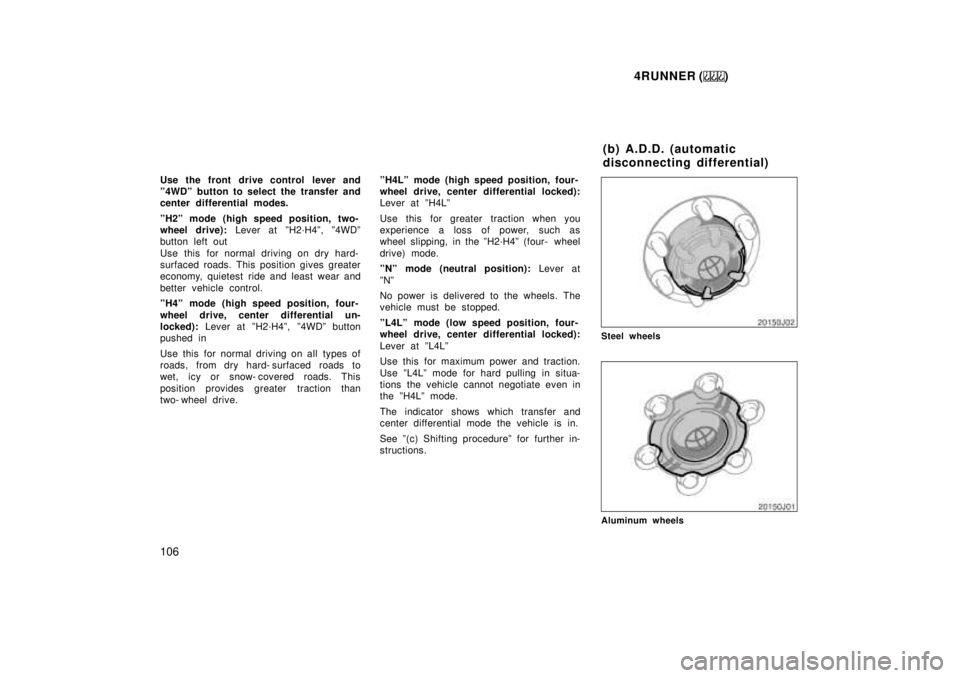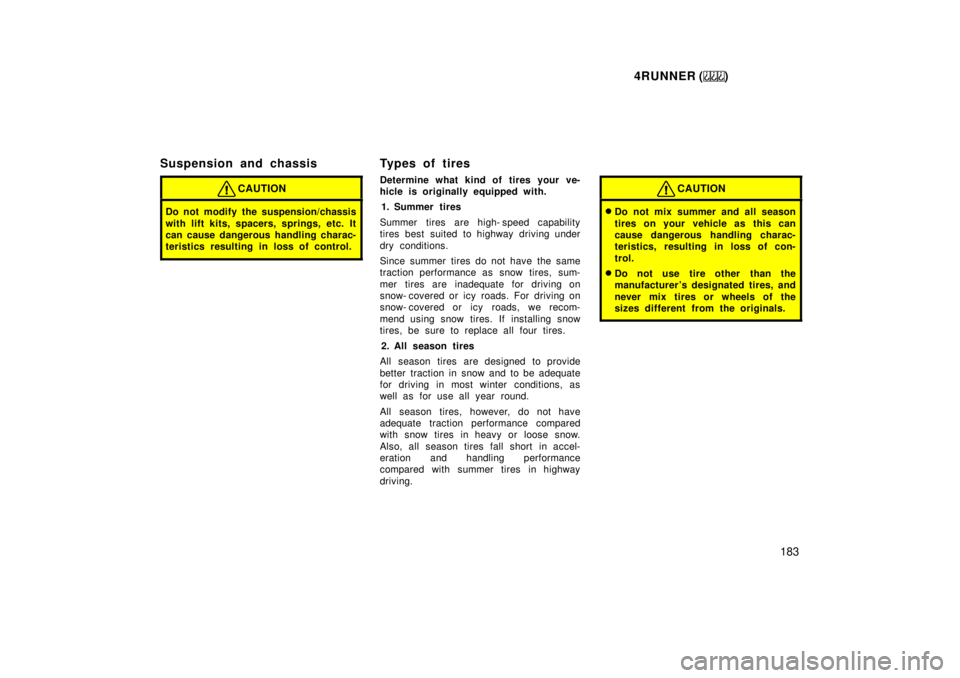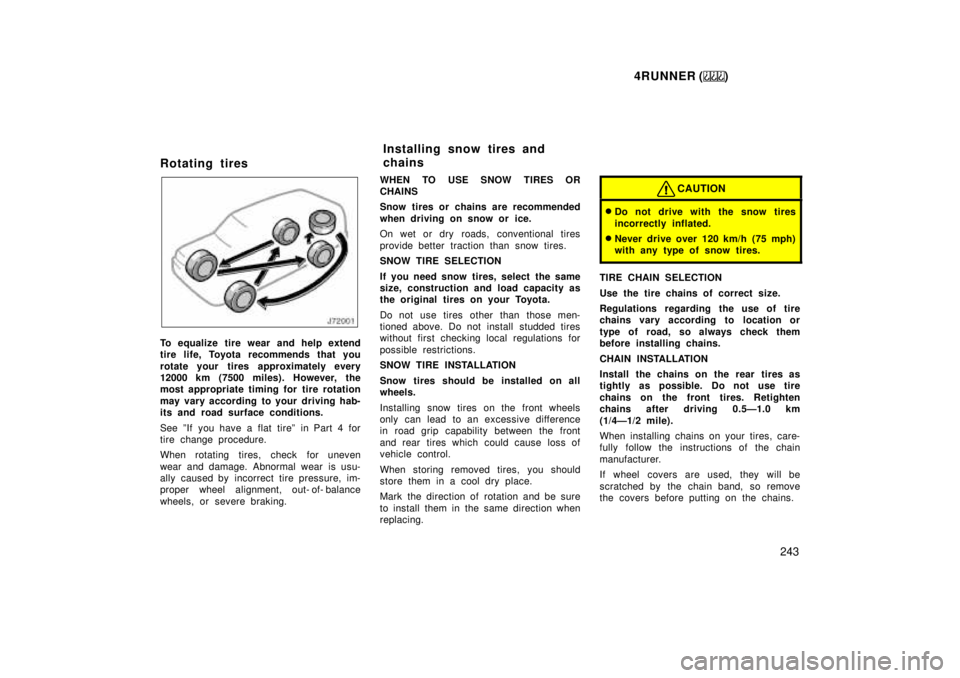traction control TOYOTA 4RUNNER 1999 Owners Manual
[x] Cancel search | Manufacturer: TOYOTA, Model Year: 1999, Model line: 4RUNNER, Model: TOYOTA 4RUNNER 1999Pages: 268, PDF Size: 2.63 MB
Page 105 of 268

4RUNNER ()105
Use the front drive control lever to se-
lect the following transfer modes.
ºH2º (high speed position, two- wheel
drive): Lever at ºH2º
Use this for normal driving on dry hard-
surfaced roads. This position gives greater
economy, quietest ride and least wear.
ºH4º (high speed position, four- wheel
drive): Lever at ºH4º
Use this for normal driving on wet, icy or
snow- covered roads. This position pro-
vides greater traction than two- wheel
drive. ºNº (neutral position):
Lever at ºNº
No power is delivered to the wheels. The
vehicle must be stopped.
ºL4º (low speed position, four- wheel
drive): Lever at ºL4º
Use this for maximum power and traction.
Use ºL4º for climbing or descending steep
hills, off- road driving, and hard pulling in
sand, mud or deep snow.
The four- wheel drive indicator light comes
on when the ºH4º, ºNº or ºL4º mode is
selected.
See º(c) Shifting procedure (lever type)º
for further instructions.
H2 mode
H4 mode
H4L, L4L or N mode
Four- wheel drive systemÐ
(a) Front drive control
(lever type)
(a) Front drive control
(lever/button type)
Page 106 of 268

4RUNNER ()
106
Use the front drive control lever and
º4WDº button to select the transfer and
center differential modes.
ºH2º mode (high speed position, two-
wheel drive):
Lever at ºH2´H4º, º4WDº
button left out
Use this for normal driving on dry hard-
surfaced roads. This position gives greater
economy, quietest ride and least wear and
better vehicle control.
ºH4º mode (high speed position, four-
wheel drive, center differential un-
locked): Lever at ºH2´H4º, º4WDº button
pushed in
Use this for normal driving on all types of
roads, from dry hard- surfaced roads to
wet, icy or snow- covered roads. This
position provides greater traction than
two- wheel drive. ºH4Lº mode (high speed position, four-
wheel drive, center differential locked):
Lever at ºH4Lº
Use this for greater traction when you
experience a loss of power, such as
wheel slipping, in the ºH2´H4º (four- wheel
drive) mode.
ºNº mode (neutral position):
Lever at
ºNº
No power is delivered to the wheels. The
vehicle must be stopped.
ºL4Lº mode (low speed position, four-
wheel drive, center differential locked):
Lever at ºL4Lº
Use this for maximum power and traction.
Use ºL4Lº mode for hard pu lling in situa-
tions the vehicle cannot negotiate even in
the ºH4Lº mode.
The indicator shows which transfer and
center differential mode the vehicle is in.
See º(c) Shifting procedureº for further in-
structions.
Steel wheels
Aluminum wheels (b) A.D.D. (automatic
disconnecting differential)
Page 183 of 268

4RUNNER ()183
Suspension and chassis
CAUTION
Do not modify the suspension/chassis
with lift kits, spacers, springs, etc. It
can cause dangerous handling charac-
teristics resulting in loss of control.
Types of tires
Determine what kind of tires your ve-
hicle is originally equipped with.
1. Summer tires
Summer tires are high- speed capab ility
tires best suited to highway driving under
dry conditions.
Since summer tires do not have the same
traction performance as snow tires, sum-
mer tires are inadequate for driving on
snow- covered or icy roads. For driving on
snow- covered or icy roads, we recom-
mend using snow tires. If installing snow
tires, be sure to replace all four tires.
2. All season tires
All season tires are designed to provide
better traction in snow and to be adequate
for driving in most winter conditions, as
well as for use all year round.
All season tires, however, do not have
adequate traction performance compared
with snow tires in heavy or loose snow.
Also, all season tires fall short in accel-
eration and handling performance
compared with summer tires in highway
driving.
CAUTION
� Do not mix summer and all season
tires on your vehicle as this can
cause dangerous handling charac-
teristics, resulting in loss of con-
trol.
� Do not use tire other than the
manufacturer 's designated tires, and
never mix tires or wheels of the
sizes different from the originals.
Page 243 of 268

4RUNNER ()243
Rotating tires
To equalize tire wear and help extend
tire life, Toyota recommends that you
rotate your tires approximately every
12000 km (7500 miles). However, the
most appropriate timing for tire rotation
may vary according to your driving hab-
its and road surface conditions.
See ºIf you have a flat tireº in Part 4 for
tire change procedure.
When rotating tires, check for uneven
wear and damage. Abnormal wear is usu-
ally caused by incorrect tire pressure, im-
proper wheel alignment, out- of- balance
wheels, or severe braking.
WHEN TO USE SNOW TIRES OR
CHAINS
Snow tires or chains are recommended
when driving on snow or ice.
On wet or dry roads, conventional tires
provide better traction than snow tires.
SNOW TIRE SELECTION
If you need snow tires, select the same
size, construction and load capacity as
the original tires on your Toyota.
Do not use tires other than those men-
tioned above. Do not install studded tires
without first checking local regulations for
possible restrictions.
SNOW TIRE INSTALLATION
Snow tires should be installed on all
wheels.
Installing snow tires on the front w
heels
only can lead to an excessive difference
in road grip capab ility between the front
and rear tires which could cause loss of
vehicle control.
When storing removed tires, you should
store them in a cool dry place.
Mark the direction of rotation and be sure
to install them in the same direction when
replacing.
CAUTION
� Do not drive with the snow tires
incorrectly inflated.
� Never drive over 120 km/h (75 mph)
with any type of snow tires.
TIRE CHAIN SELECTION
Use the tire chains of correct size.
Regulations regarding the use of tire
chains vary according to location or
type of road, so always check them
before installing chains.
CHAIN INSTALLATION
Install the chains on the rear tires as
tightly as possible. Do not use tire
chains on the front tires. Retighten
chains after driving 0.5Ð1.0 km
(1/4Ð1/2 mile).
When installing chains on your tires, care-
fully follow the instructions of the chain
manufacturer.
If wheel covers are used, they will be
scratched by the chain band, so remove
the covers before putting on the chains.
Installing snow tires and
chains
Page 268 of 268

4RUNNER ()
268
Uniform tire quality grading
This information has been prepared in ac-
cordance with regulations issued by the
National Highway Traffic Safety Adminis-
tration of the U.S. Department of Trans-
portation. It provides the purchasers and/
or prospective purchasers of Toyota
vehicles with information on uniform tire
quality grading.
Your Toyota dealer will help answer any
questions you may have as you read this
information.
DOT quality gradesÐAll passenger ve-
hicle tires must conform to Federal
Safety Requirements in addition to
these grades. These quality grades are
molded on the sidewall.
Treadwear
ÐThe treadwear grade is a
comparative rating based on the wear rate
of the tire when tested under controlled
conditions on a specified government test
course. For example, a tire graded 150
would wear one and a half (1- 1/2) times
as well on the government course as a
tire graded 100. The relative performance
of tires depends upon the actual condi-
tions of their use, however, and may de-
part significantly from the norm due to
variations in driving habits, service prac-
tices and differences in road characteris-
tics and climate. Traction AA, A, B, C
ÐThe traction
grades, from highest to lowest, are AA, A,
B, and C, and they represent the tire's
ability to stop on wet pavement as mea-
sured under controlled conditions on spe-
cified government test surfaces of asphalt
and concrete. A tire marked C may have
poor traction performance.
Warning: The traction grade assigned to
this tire is based on braking (straight
ahead) traction tests and does not include
cornering (turning) traction.
Temperature A, B, C ÐThe temperature
grades are A (the highest), B, and C,
representing the tire's resistance to the
generation of heat and its ab ility to dissi-
pate heat when tested under controlled
conditions on a specified indoor laboratory
test wheel. Sustained high temperature
can cause the material of the tire to de-
generate and reduce tire life, and exces-
sive temperature can lead to sudden tire
failure. The grade C corresponds to a lev-
el of performance which all passenger car
tires must meet under the Federal Motor
Vehicle Safety Standard No. 109. Grades
B and A represent higher levels of perfor-
mance on the laboratory test wheel than
the minimum required by law. Warning: The temperature grades for this
tire are established for a tire that is prop-
erly inflated and not overloaded. Exces-
sive speed, underinflation, or excessive
loading, either separately or in combina-
tion, can cause heat buildup and possible
tire failure.